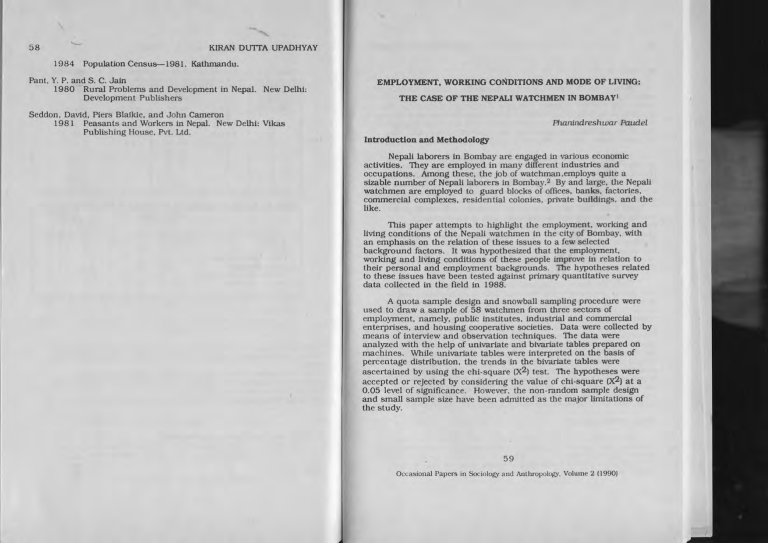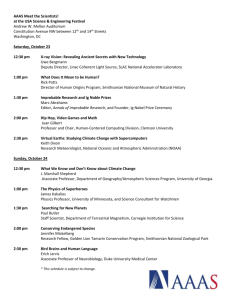Employment, Working Conditions and Mode of Living: The Case of

58 KIRAN DUlTA UPADHYAY
1984 Population Census-1981. Kathmandu.
Pant. Y. P. and S. C. Jain
1980 Rural Problems and Development in Ne.paI.
New Deihl:
Development Publishers
Seddon. David. Piers Blalkie. and John Cameron
1981 Peasants and Workers in Nepal. New Dellil: Vikas
Publishing House, Pvt.
Ltd.
EMPLOYMENT, WORKING CONDITIONS AND MODE OF LIVING:
THE CASE OF THE NEPALI WATCHMEN IN BOMBAY I
Phanindreshwar Paudel
Introduction and Methodology
Nepali laborers in Bombay are engaged in various economic activities. They are employed in many different industries and occupations. Among these. the job of watchman.employs quite a sizable number of Nepali laborers in Bombay.2 By and large. the Nepali watchmen are employed to guard blocks of offices, banks, factories, commercial complexes. residential colonies. private buildings. and the like.
This paper attempts to highlight the employment. working and living conditions of the Nepali watchmen in the city of Bombay. with an emphasis on the relation of these issues to a few selected background factors.
It was hypothesized that the employment, working and living conditions of these people improve in relation to their personal and employment backgrounds. The hypotheses related to these issues have been tested against primary quantitative survey data collected in the field in 1988.
A quota sample design and snowball sampling procedure were used to draw a sample of 58 watchmen from three sectors of employment. namely. public institutes. industrial and commercial enterprises. and housing cooperative societies. Data were collected by means of interview and observation techniques. The data were analyzed with the help of univariate and bivariate tables prepared on machInes. While univariate tables were interpreted on the basis of percentage distribution, the trends in the bivariate tables were ascertained by uSing the chI-square (X2 ) test. The hypotheses were accepted or rejected by conSidering the value of chi-square
0(.2)
at a
0.05 level of significance.
However. the non-random sample design and small sample size have been admitted as the major limltations of the study.
59
OcLa~iollal Paper" in Sociology and AutllToJXlIOj!y. Vohmw 2 (1990)
60
PHANINDRESHWAR PAUDEL
BackgroUDd
Most of the Nepali watchmen in Bombay come from the hill areas of Jhe Far Western Development Region (FWDRI of Nepal, particularly the DoU. Achham, BaJtadt and Dadeldbura districts. The economy of the hUls of the FWDR Is mainly characterized by a scarclly of farm land. Iowagr1cultural produCtivity, little non-fann employment and short- and Janglerm labor migration (See CBS 1987; EIU 1981;
EIU 1982: Dahal, Ral and ManzaTdo 1977).
In
On the average. the people of the FWDR are poor and indebted.
order to meet their hou~hold expenses and make payments on their loans. they have to look for work outside the area. Due to the lack road and transport linkages with the rest of Nepal, they have little exposure
Or" contact with other pans of the country. The small sJu of the lndust.rtal sector and the scarce non-farm employment elsewhere in Nepal (CBS 1987; 197). coupled with massive underemployment among the rural and agricultural labor force in the country.
discourages workers from remaining in Nepal
to
work.
Relatively man: exposure to the Indian border and extensive road and traO!lport
facilities in India gives the NepalI laborers much easi~ access to the big towns and dUes of India. Bombay, because it Is bJghJy industrialized and has many Nepali lnunIgrants, particularly appeals to them.
Since the Nepali immigrants are rural, poor. and for the most part young, they come
to
Bombay With lIttle or no education and no non·fann experience. Thus it is utremely difficult for them to get access to skilled or technical jobs In the city.
On the othel'" hand. their reputation as -the brave, sincere and honest Gurlthas- has made It easier for them to find jobs as watchmen. chowlddars and guards.
These people are the most trusted and, therefore, most preferred candidates for such jobs. In the city of Bombay, the job of watchman has been stereotyped as that of ·the Gurkhas'. The teon 'Gurkha' Is usually applied to all watchmen, even if they are not Nepali. This stereotype suggests that the watchman job Is easily accessible to
Nepali people.
Besides. the old workers make jobs more accessible to the latter through the chain of contacts between the old workers and new arrivals. They prov:lde Information about jOb opportunities, vacancies. etc.. and make recommendations to prospective employers.
Sector of Employment
In Bombay. Nepali laborers work as watchmen in the follOwing sectors of employment: {I) public institutions, (2) manufacturing and commercial establishments. (3) housing cooperative societies, and (4)
Independent or private buildings and shops, in which case they are called 'street watchmen'.
EMPLOYMENT. WORKING CONDITIONS AND MOm: OF LIVING 61
The employment and working conditions of W'o:l.tchmen arc different in each of these sectors of employment. Although the employment and working conditions In private institutes are strictly regulated by rules and regulations, these may not be practiced In the manufactUring and c~rcla1 establishments. In the housing cooperative societies, rules and regulations may not exist at all. The employment and working conditions of the 'street watchmen' employed to guard indIvidual or private buildings and shops during the night are the least regulated legally (Sinha 1977:5).
The average duration of star of Nepali watchmen in Bombay Is about ten yecus. Those who stay longer are generally older. At first they start 'WOrk in housing societies. As lime
goes
on. they shift from housing to private industries. and then to public Institutes. Simllarly, the young watchmen start in the housing sector. while the elder ones settle in the public institutes. The rationale behind this pattern is that the younger immigrants begin work In the less organized and regulated housing societies.
More experienced and older workers accwnulate market exposure. information, and contacts wilh natives.
allowing them eslabUshments.
to
join more organized and better regulat('d
Education plays an insignificant role in obtaining jObs. The watchmen do not significantiy differ in their educational background.
which is Utile. They do not receive formal education in their work, even in the public industries and institutes.
Employment and Working Conditions
Initially, the only occupational experience of th(' Ncpali watchmen in Bombay is that of owner cultivators or agricultural laborers. In Bombay. many have taken a variety of jObs in addition or prior to that of watchman. These include domestic servant. peon.
factory worker. plumber. helper, cook. hotel boy. and milk boy In commercial and industrial enterprises. They leave their jObs one aftet" another. mainly to return to Nepal for visits.
The reasons for the unsteady character of their work reveal two interrelated characteristics of employment conditions in the privatc sector. These are lack of Jab security and Icave facilities on the part of the employers. and lack of corrunitmcnt to particular jobs on the part of lhe watchmen.
Due to the temporary. ad hO<' nature of ('mployment and working conditions. the Nepali workers set'k employment for supplementary income for their households in Nepal. nol itS a career.
Their attachmenl to Iht'ir famlly in Nepal is slill primary.
TIle average watchman has been working on tilt" same jOb for the past seven months or so. Hf' draws an avemg:e salary of R~.
757 per month.
Past job experience docs nol ~;;(,(,Ill 10 impfllV(' pn'sGIlI
62
PHANINDRESHWAR PAUDEL salaries.
This may also bt' a l.'Onlribullng factor in the frequent job changes. since there is no inducement to remain at the same job. The primary ~n for changing jobs Is to go to Nepal. When the labore;r.J
return from Nepal. they take whatever job Is avaJlable. irrespective of the salary. Often, the salary of the next job is less than that of the previous one.
Watchmen in the public sector enjoy greater job security and beneflts than those In the private sector. They work a fixed 8 hour workday, with weekly holidays and leave facilities. They are provided equipment such as truncheon and torch.
rain coats or umbrellas, wann clothes.
boots and unifonns appropriate to the hour and the season. They enjoy fringe benefits and facJUlics. such as tncrement.
prOvident fund, medJcaJ facilities, and housing. The housing. unlike
'free accommodation', may be either consist of rent-free quarters or a housing allowance. Watchmen in the pubUc sector usually do not work overtime, and, If tiley do, they are relmbursed "1th overtime pay equal
to
or greater than thelT regular rate of pay.
vary
Employment and working conditions In the fndustrial sector from organization to organization. Watchmen working for manufacturing industries, especially those in the public sector, are permanent employees with a fiXed 8 hour workday. weekly holidays, and leave facility. However, even those with
an
8 hour workday usually work 12 hour days, seven days a week, In order to earn overtime pay which between one and two times the usual wage rate. The kinds of equipment supplied
to
the industrial employees include various comblnatlons of truncheon, torch, umbrella or raincoat.
wann
clothes.
boots and dress. The same goes for frtnge benefits and facilities such as Increments. provident funds, bonuses, and medical and hOUSing faclllUes.
Conunerclal employees receive less benefits than Industrial ones. especially In the private sector. They are generally employed temporarily with twelve hOUT working days. They mayor may not receive weekly holidays and leave facilities.
Watchmen In housing cooperatives are also employed temporarily. They have twelve hour working days and seven day workwrpks. They enjOy no holidays, leave facilities or frtnge benefits other than increments to thelT monthly salary and housing facilities in the fonn of 'free accommodation'.
Unlike rent-free quarters the 'free accommodation' is. infonnal and ad hoc. These workers do
~ot work overtime, and. among the various categories of watchmen, they are the ones who most commonly take odd Jobs In addition to their watchman job. In the mornings they usually clean the automobiles of the residents of the colony for which they work. For this they are paid Rs.
30 to 40 per car per month. They also do domesllc work for the residents, usually for tips.
EMPLOYMENT. WORKiNG CONDITIONS AND MODE OF LIVING 63
The employment and working conditions of the Nepali watchmen In Bombay
are
poor, especially in the hOUSing cooperatIves where the benefits and factlltles
are
the leagt. GeneraUy. working conditions. seem to be positively ~lated to the sector of employment and the personal backgrounds or the watc1unen. Public institutes provide the best working condltlons, and after them the industrial sector. while hOUSing societies provide the worst conditions.
Aspects of the personal backgrounds that seem significant are age and present tenure of employment. Older watchmen and ones who have been working longer at the same Job enJoy bener working conditions than younger or more recently employed ones.
As Nepali immigrants grow older and work longer in Bombay, they tend to shift from the worst sectors
to
better ones. They initially work in the houSing sector. then in prtvate Industry, and fmally in the comparatively strictly regulated public institutes. Due to the better
~gulation and more permanent character of the jObg in the publiC institutes, the Nepali watchmen the~ lend to remain for longer perlods. The longer duration of employment facilitates the further bettennent of their conditions.
Education and previous job experience as elsewhere seem to be inslgnif]cant factors, either for obtaining jObs or bettering their working conditions.
Generally, the people who are searching for watchmen jObs are not greatly cUiTerentiated by education anyway.
Mode of Life
On the whole, the way of life of Nepali watchmen in Bombay Is unsettled. disorganized, and ad hoc.
For housing, many watchmen live as frugally as possible In rentfree but inconvenient and informal shelters provided by the employers within the work places. These include small huts. rooms under stairs, hardware storerooms, water pump shades, and open sky garages.
Shared by co-workers. including friends and relatives. these shelters are small, congested and overcrowded.
Consequently. the watchmen in these quarters cannot think of bringing their lmmediate families to live with them. They cook In the shelters and sleep in the verandah or similar spaces in thelT work place, such as In a garage.
Some watchmen live in rent-free quarters within the work place. These are either kuchha or pukka houses (buildings). The kuchha houses are small and congestcd. The pukka ones seem to be lhe most convenient of all the housing types. These quarters. unlike the free accommodations. more or less saUsfy minimum housing needs. The ....,orkers Ilvin~ In these are relatively organized. more settled and pcnnanent. TIle watchmen In the pukka quarters are found wHh their famllil's.
-
64 PHANINDRESHWAR PAUDEL
Some watchmen rcnt space outside their work place In Hoy.
congested huts, usually in the slum areas.
For food. the watchmen arrange tea and two frugal meals a day.
lunch and dinner. Breakfast is unconunon. They share their food with the other people In their quarters. depending upon the type of arrangement.
The watchmen like to rest during their leisure time. This is not surprismg. considering their long workweek.
In addition to resting, they gossip,
go
to the cinema. play cards, visit friends and relatives.
listen to the radio, and read books. 1\vo charactertstics may be noted about their leisure time. They do not spend money. cJrcept at the cinema, and their activities center on their co-workers or families.
Only viewing the cinema can be described as a specifically urban charactertstic.
In the manner of the watchmen's working conditions, their living condltlons5 seem to be poSitively related to their personal backgrounds. including age and tenure of stay. and the sector of employment.
Older watchmen live relatively more settled lives in
Bombay than the younger ones. and ones who have been there longer live better than those who have been there only a short time. Ones who work in public institutions are relatively more settled than those in Industries. and those in cooperative societies are the least unsettled.
Again.
education does not seem to be a factor.
Again. the relationship between the two factors can be drawn.
Those who live more settled lives have been in Bombay longer. and those who have lived and been employed in Bombay longer work in public institutions.
In conclusion. the sector of employment detennines the level of life. As the watchmen remain in Bombay longer. they shift from the hOUSing sector to industry. and then to the well-regulated employment in the public institutions.
A poSSible implication is that the watchmen cannot or do not stay a long time in
Bombay on an ad hoc basis. Either they manage to settle themselves.
or they leave the city for their homes In Nepal.
Swnmar:y and Conclusion
The Nepali watchmen in Bombay are characterized by an unsettled. unorganized and ad hoc way of life in the city. Newcomers are generally employed in housing cooperatives and experience the worst conditions.
As they grow older and spend more years in
Bombay. they shift their employment to the Industrial and public sectors. where their worldng conditions Improve respectively.
The sector of employment seems to be the most immediately detennlning factor in their conditions of employment and life In the city.
EMPLOYMENT. WORKING CONDITIONS AND MODE OF LIVING
Education and previous jOb experi~nce do not seem to be so important.
65
However. changes are taldng place. Unlike a few years
ago.
it Is much more d(fficult to find jobs In the well regulated employment sectors such as public Institutions and Industries. Provisions regarding age. educational background. occupational background and.
in some cases. even nationality have been Introduced. For example.
the most preferred candidates for watclunen in banks or manufacturing are those with some education and military experience.
especially anny retirees.
The newly arriving younger Nepali Immigrants are confined to either housing cooperative societies or industrial conunercial establishments run by the private sector. This indicates that in the future.
if not now. young iJrunigrnnts with little or no education. and occupational backgrounds limited to owner-cultivation or agricultural labor as characterizes the vast majority of Nepali people. may have little access to the job of watchmen. except under the poorest and least regulated conditions. dOOming them to pauperism.
Notes
IThis paper is based on fieldwork carried out in 1988 for the project report submitted to the Tata Institute of Social SCiences. Bombay for a
Postgraduate Certificate in Research Methodology.
'
2There are no data available regarding the exact numbers of the Nepali laborers v.urking as watchmen in Bombay.
3'Jbe duration of the stay in Bombay does not necessarily mean a continuous one. The overall period is a more or less net stay in
Bombay in the sense that it does not include any stay in Nepal for one year or more from the frrst migration to Bombay.
4Working conditions as a variable represent a composite quantification of cmplo~ment.
working hours. holidays. leave facility. protective equipment. and fringe benefits and facilities in tenns of their operational measures.
The ovcrall Index or score of working conditions was divided into a trichotomy of low. moderate and high.
mainly for the purpose of comparison.
5Living conditions as a variable were quantified and taken compositely in the form of housing conditions (types of house. house status and staying arrangement). food arrangement. and leisure time activities in tenns of their operational measures. The overall index or score of living conditions \vas divided into a lrichotomy of low. moderate and high. mainly for the purpose of comparison.
References cited
Central Bureau of Statistics (CBS)
198 I Population Mono~raph of Nf'pal. Kathmandu.
66
KIRAN DUTTA UPAOHYAY
Dahal, n.R ..
N. K.
Raj and Andre",' E. Manzardo
1977 Land and MlgraUon in Far Western Nepal. Kathmandu:
INAS, Trtbhuvan University.
economist IntellJgence Unit
IEIUI
1981 Quarterly &onomlc Review of India, Nepal; Annual
Supplement 1981. London.
1982 Quarterly Economic Review of India. Nepal; Annual
Supplement 1982. London.
Sinha. hun
1977 Night Watchmen of Patna. Industry Security TImes. Vol.
XIII, NO.1 (Aprtl). Bombay.
TELEVISION AND THE CHILD IN NEPAL:
AN ASSESSMENT OF VIEWING PATBRNS
Television was inltlally Introduced into Nepal (rom the fourth of
Fagun. 1041 B.S. on a trtal basiS.
Regular transmission conunenced from the 14th of Paush, 2042 B.S. Now, with the transmission of morning "programs. in addition to the evening ones, from Its studio in
Singha Durbar, Nepal Television (N'IV) broadcasts four and a half hounI a day.
The establishment of the Biratnagar televisIon center allows television programs
to
reach a much larger audience. especially
Central and TaraJ region.
in the
The morning transmission in Katlunandu starts with a religious program conststing of devotional songs (Bhajan) and dtscourses on
Hinduism and Buddht.sm (Pravachan). nus is followed by news headlines. Then after a light variety program. the mornIng program concludes with a bulletin of news 10 NepalJ.
1
In the evening transmission. the regula.T progranuntng includes an educational program for children. news bulletins in Nepali and
EngUsh. and the current affairs program ·Aath Baje· (Eight O·clock).
Besides dramas events
these.
there
are
entertainment programs. Including te1e.01ms.
and serials.
and weekly programs on current international
caned
~iswa Ghaloa.-
Among all of the programs, the ones with the highest rate of
VIewing among children are the chlldren's educational program
·Srijana Ko Adha Ghanta: the English serial Ihe A·Team.· and. more recently. the serial epic "Ramayana.-
An average child from a middle class family:!: in Kathmandu watches about an hour of television daily. He or she may view continuously or in two or three phases of about a half hour each the average length of
a
program.
This study focuses on the middle class child for the following reasons. Chlldren from upper class families can be expected to be exposed to both television and video, with a usual preference for the
67
Occa'lional ?ape"" in SocioIOfO' and Anthropoklgy.
VoIlWle 2 (19901
-






